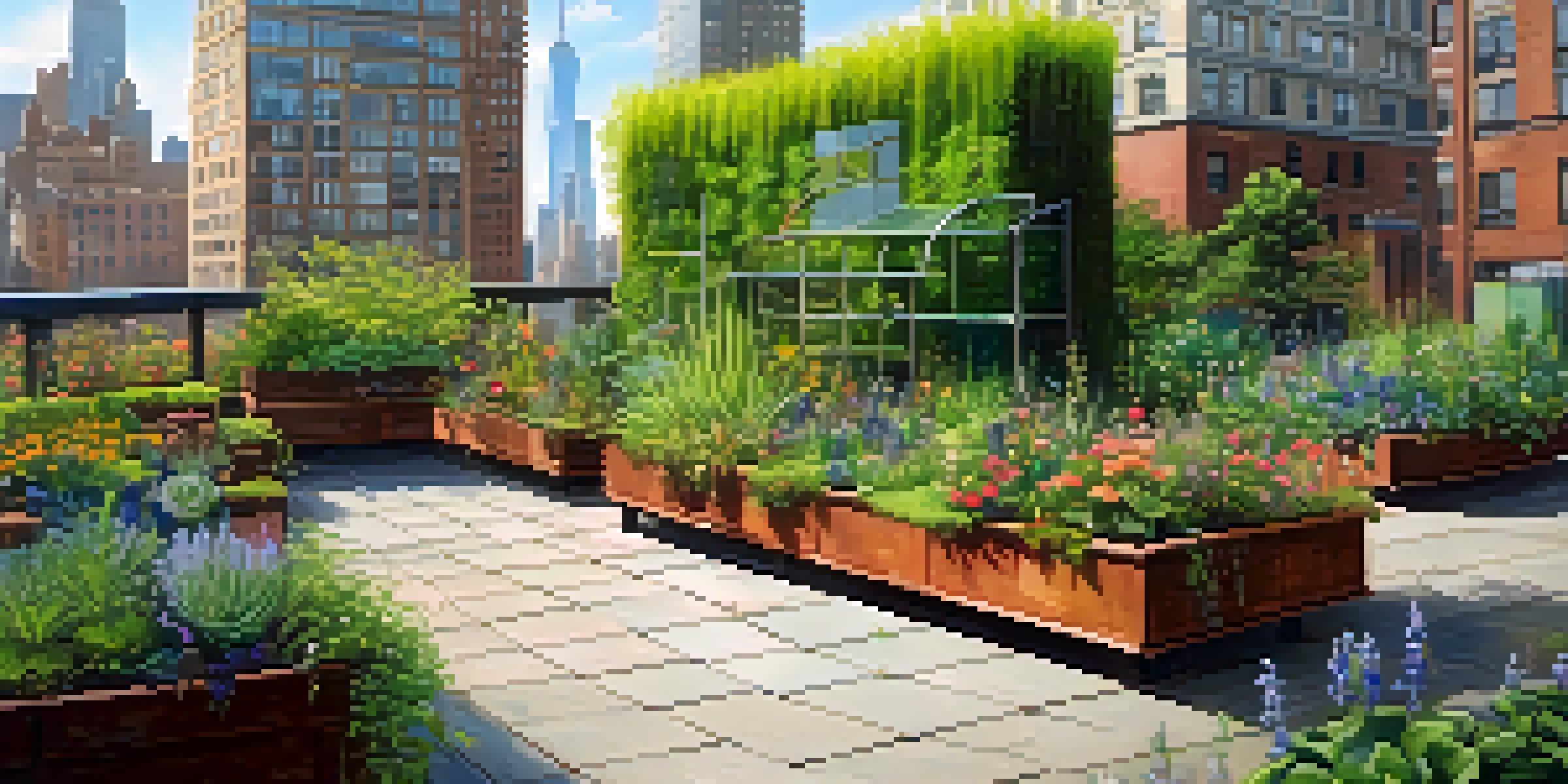Innovative Green Roofs: Transforming NYC's Urban Landscape

Understanding Green Roofs: What Are They?
Green roofs are a sustainable architectural solution that involves growing vegetation on rooftops. They serve not only as insulation but also as a way to manage stormwater, improve air quality, and enhance biodiversity in urban settings. Think of them as mini ecosystems right above our heads, turning concrete jungles into green expanses.
The greening of our cities is not just a matter of aesthetics; it's an essential step towards sustainability and resilience in the face of climate change.
In New York City, where space is limited and the skyline is dominated by towering buildings, these green roofs offer a unique opportunity to reclaim some of that lost greenery. Not only do they beautify the city, but they also provide habitats for birds and insects, contributing to a healthier urban environment. Imagine walking through the city and spotting butterflies fluttering about or listening to birds chirping from a rooftop garden.
The concept of green roofs may sound modern, but it actually has deep historical roots. Many ancient civilizations, such as the Vikings and the Mesopotamians, utilized similar techniques to insulate their homes and grow food. Today, as we face increasing urbanization and climate challenges, green roofs are becoming an essential part of sustainable city planning.
Benefits of Green Roofs: More Than Just Aesthetic Appeal
One of the most significant benefits of green roofs is their ability to reduce the urban heat island effect. This phenomenon occurs when cities become significantly warmer than their rural surroundings due to human activities and infrastructure. By incorporating green roofs, NYC can help lower temperatures, making the city more comfortable during those sweltering summer months.

Additionally, green roofs play a vital role in stormwater management. They absorb rainwater, reducing runoff and minimizing the risk of flooding. This is especially crucial in a city like New York, which often experiences heavy rainfall and has struggled with flooding in the past. Imagine a green roof acting as a sponge, soaking up water and releasing it slowly, rather than overwhelming the city’s drainage systems.
Green Roofs Enhance Urban Ecosystems
Green roofs serve as mini ecosystems that improve air quality, manage stormwater, and provide habitats for wildlife in urban environments.
Moreover, green roofs contribute to improved air quality. Plants naturally filter pollutants and produce oxygen, helping to combat the effects of pollution in urban environments. As more people flock to the city, enhancing air quality through green initiatives becomes a priority for public health and well-being.
Case Studies: Successful Green Roof Projects in NYC
Several notable green roof projects in New York City showcase the potential of this innovative approach. For instance, the Brooklyn Grange is a rooftop farm that not only produces fresh vegetables but also hosts educational workshops on sustainable farming practices. This endeavor not only feeds the community but also raises awareness about the importance of local food sources.
Green roofs are not just a trend; they are a necessity for creating livable urban environments amid rapid urbanization.
Another impressive example is the green roof atop the Javits Center, which spans over 6.75 acres. This space not only serves as a habitat for various species but also supports the center's sustainability initiatives, including energy efficiency and stormwater management. It’s a prime example of how large-scale institutions can lead the way in green innovations.
These case studies highlight the versatility of green roofs, demonstrating that they can be integrated into both residential and commercial spaces. As more New Yorkers recognize their benefits, the demand for green roofs is likely to rise, prompting further innovations in design and implementation.
Challenges to Implementing Green Roofs in NYC
Despite the many benefits, implementing green roofs in NYC is not without its challenges. One significant hurdle is the initial cost of installation. While green roofs can save money in the long run through energy savings and stormwater management, the upfront investment can be a barrier for many property owners.
Another challenge is the structural integrity of existing buildings. Not all rooftops can support the added weight of a green roof, which requires careful planning and engineering assessments. This limitation often means that only new constructions or major renovations can incorporate green roofs, leaving older buildings out of the equation.
Challenges in Green Roof Implementation
Despite their benefits, high installation costs and maintenance needs pose significant challenges for adopting green roofs in NYC.
Lastly, maintenance is a crucial factor in the success of green roofs. Unlike traditional roofs, which require minimal upkeep, green roofs need regular care to thrive. This includes watering, weeding, and ensuring plants are healthy, making it essential for building owners to commit to long-term maintenance plans.
The Role of Government in Promoting Green Roofs
The government plays a vital role in promoting green roofs within urban environments. In NYC, initiatives like the Green Infrastructure Grant Program provide funding to property owners looking to install green roofs. These incentives make it more financially feasible for individuals and businesses to embrace sustainable practices.
Furthermore, local policies and zoning regulations can encourage or discourage the development of green roofs. By creating a supportive regulatory framework, the city can foster an environment where green roofs become a standard aspect of new developments. This shift can lead to a more sustainable urban ecosystem overall.
Additionally, public awareness campaigns can educate New Yorkers about the importance of green roofs and their benefits. By engaging the community and showcasing successful projects, the government can inspire more residents to consider green roofs as a viable option for their buildings.
Community Engagement: Involving New Yorkers in Green Initiatives
Community engagement is essential for the success of green roof initiatives. By involving residents in the planning and maintenance of these green spaces, cities can foster a sense of ownership and pride. Community gardens on rooftops can become gathering spaces where neighbors can connect while tending to the plants and enjoying fresh produce.
Workshops and educational programs can also encourage locals to get involved. For example, teaching residents about the benefits of green roofs and how to care for them can empower individuals to advocate for more green initiatives in their neighborhoods. It’s about creating a movement that goes beyond just planting flowers and vegetables.
Government's Role in Green Initiatives
Government support through funding and regulations is essential for promoting the widespread installation of green roofs in New York City.
Moreover, collaboration between community organizations, local businesses, and government can lead to innovative projects that serve the needs of the community while promoting sustainability. When New Yorkers come together, they can transform their urban landscape into a greener, more vibrant city.
The Future of Green Roofs in NYC: A Sustainable Vision
As we look toward the future, the potential for green roofs in NYC is both exciting and promising. Advances in technology and design are making it easier to incorporate green roofs into urban architecture. From lightweight materials to automated irrigation systems, these innovations are enhancing the feasibility of green roofs.
Moreover, as climate change continues to impact our cities, the need for sustainable solutions like green roofs will only grow. They can play a crucial role in mitigating the effects of climate change by reducing heat, improving air quality, and managing stormwater. The vision for a greener NYC is not just a dream; it’s an achievable goal.

Ultimately, the future of green roofs in New York City lies in collaboration and commitment from all stakeholders. By investing in this transformative approach, we can create a healthier, more sustainable urban environment for generations to come. Embracing green roofs is more than just a trend; it’s a step towards a resilient future.